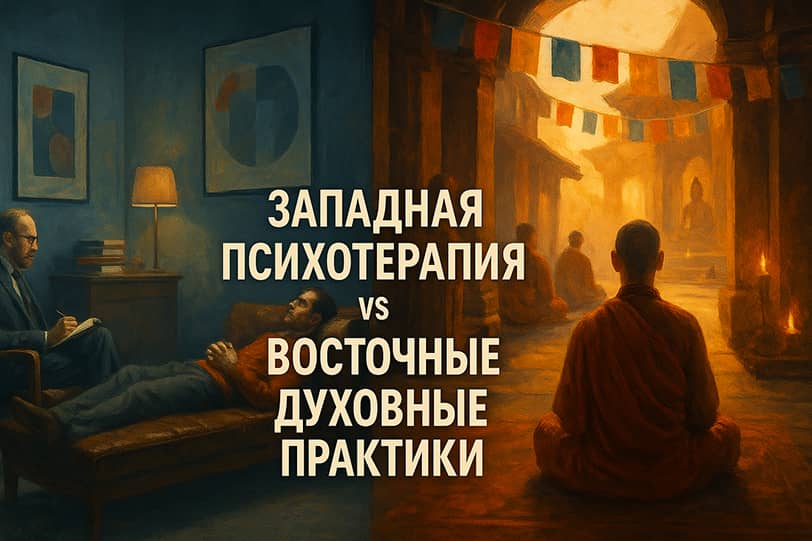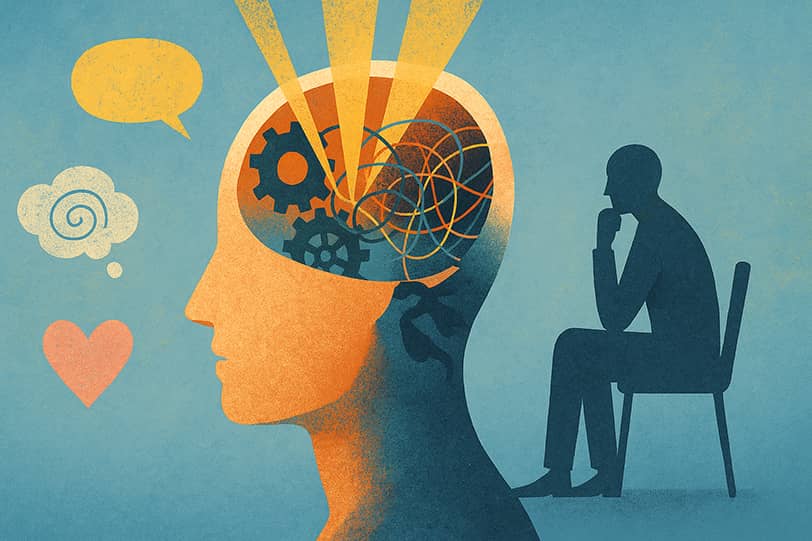In the modern world, where the boundaries between cultures are becoming increasingly transparent and the demand for emotional well-being is growing, psychology is no longer a monolithic science with a single approach. On the contrary, it reflects the diversity of human experience, offering fundamentally different methods of healing—depending on where and by whom these methods were developed.
Western psychotherapy, with its strict protocols and evidence-based foundation, and Eastern practices, rooted in philosophy and spiritual traditions, often seem like opposites. But is this really the case? And is it possible to find common ground between analyzing childhood traumas on a European psychoanalyst’s couch and meditating in a Himalayan ashram?
Globalization is not only erasing geographical barriers but also pushing people to seek help beyond familiar systems. Some become disillusioned with the “pills and talk therapy” of the Western model, while others remain skeptical of the “unscientific” Eastern methods. At the same time, cultural differences play a key role: what is considered normal in the individualistic societies of Europe or the U.S. may not apply in the collectivist cultures of Asia, where spiritual health is inseparable from harmony with society and nature.
This article is an attempt to explore how psychological support works in different parts of the world and to identify which principles are worth adopting. How do Western therapists combine rationality and empathy? Why do Eastern gurus rarely give diagnoses, yet their students feel relief? And most importantly—is it possible to combine the strengths of both approaches to create a more holistic system of mental well-being? The answers to these questions will not only help us better understand ourselves but also make more conscious choices on the path to inner balance in a world where traditions and innovations are becoming ever more intertwined.

Western Therapy: Science, Structure, Evidence-Based Practice
In the Western world, psychology has long ceased to be something mysterious and esoteric—it has become a rigorous science with its own laws, methods, and criteria for effectiveness. While Eastern approaches often speak of “harmony” and “enlightenment,” here the focus is on diagnoses, protocols, and statistics. But what exactly makes Western therapy so systematic? And why do millions of people around the world choose this path despite criticism of its “excessive rationality”?
Before delving into the details, it’s important to understand the main point: Western psychotherapy is not a single method but rather a multitude of schools and approaches united by a common principle. They all rely on scientific research, prioritize individuality, and strive for measurable results. From classical psychoanalysis to modern digital therapy apps—this approach has proven its effectiveness, but it also has its limitations. Let’s explore how it works, where it’s applied, and who benefits from it the most.
Core Principles
1. Reliance on scientific research
Western psychology takes pride in the fact that its methods can be tested. Unlike spiritual practices, where results often depend on personal experience, here everything is built on experiments, clinical trials, and meta-analyses. For example, cognitive-behavioral therapy (CBT) – one of the most popular methods—was originally developed as a scientific alternative to psychoanalysis. Its techniques (such as working with automatic thoughts) have been tested in labs and shown high efficacy for anxiety and depression.
The same can be said about other approaches:
- Psychoanalysis (though criticized for lacking empirical evidence) is based on years of observation of unconscious processes.
- Gestalt therapy combines psychology with philosophy but still uses clear techniques like the “empty chair” exercise.
- Schema therapy and DBT (Dialectical Behavior Therapy) are newer methods but already backed by hundreds of studies.
2. Focus on individuality, personal responsibility, and rational analysis
While the East often sees a person as part of a greater whole (family, society, the cosmos), Western therapy concentrates on personal history. It doesn’t expect problems to resolve “on their own” through meditation or acceptance—instead, it teaches people to analyze their thoughts, take responsibility for change, and take action.
For example:
- In CBT, clients are literally given “homework”: writing down negative thoughts, checking their logic, experimenting with new behaviors.
- Existential psychotherapy encourages individuals to seek their own meaning in life rather than follow rigid doctrines.
- Even in group therapy, the emphasis is on each participant’s personal progress, not dissolving into the collective.
3. Strict protocols and diagnostics (DSM, ICD)
For treatment to be effective, it must be standardized. That’s why Western psychology has long relied on diagnostic manuals—DSM-5 (American Psychiatric Association) and ICD-11 (World Health Organization). These outline symptoms, diagnostic criteria, and even recommended treatment methods.
This means depression in New York and Berlin will be diagnosed using the same criteria, and treatment will likely start with antidepressants and CBT. On one hand, this simplifies specialists’ work; on the other, critics argue that such an approach “packs” real people into narrow diagnostic boxes.
How It Works
Examples: Therapy in the US, Europe, Israel
- In the US, psychotherapy is part of the healthcare system. Insurance often covers sessions, but the methods vary by state: CBT dominates in some places, psychoanalysis in others. Americans also love coaches and motivational speakers, who emerged from psychological schools.
- In Germany, classical psychoanalysis remains influential, but short-term therapies (e.g., systemic family therapy) have gained popularity in recent years.
- In the UK, the NHS (National Health Service) prioritizes evidence-based methods, making CBT the gold standard.
2. Formats: In-person sessions, group therapy, online counseling
Therapy used to mean a couch, an office, and hours of talking. Now, there are many more options:
- Traditional one-on-one sessions (45–60 minutes)
- Group therapy (especially popular for addictions)
- Online platforms like BetterHelp, where you can chat with a therapist via video or text
- Even mobile apps with therapeutic elements (Woebot, Headspace)
Pros and Cons
✔ Effective for depression, anxiety, PTSD
Studies show CBT helps 50–60% of patients with depression, and DBT significantly reduces suicide attempts in people with borderline personality disorder. The advantage of Western methods is predictability: if a technique works in Chicago, it will likely work in Paris too.
✖ Can seem too “cold,” ignores the spiritual aspect
The main criticism of Western therapy is its “mechanical” nature. Not everyone wants to dissect their problems like a math equation—some need a connection to something greater (nature, God, the universe). Additionally, not all methods account for cultural differences: for example, a Latino or Asian person might feel uncomfortable with the emphasis on personal responsibility if their culture values family support.
Western therapy is a powerful tool, especially when quick and clear solutions are needed. But it doesn’t claim universality, and for many, the ideal option is a combination of the “scientific” approach with Eastern practices.

Eastern Wisdom: Harmony, Wholeness, Traditions
While Western psychology categorizes the mind into compartments, the Eastern approach offers a fundamentally different idea: you cannot heal the mind without addressing the body and spirit. Here, there are no standard questionnaires or DSM diagnoses—instead, there are centuries-old traditions that teach a person to live in harmony with themselves and the world. But how exactly do these methods work? And why, despite their seeming “lack of scientific rigor,” do they help millions find inner peace?
Eastern psychology (though it would be more accurate to call it a collection of spiritual and healing practices) is built on the idea of wholeness. If the West might treat anxiety with pills and cognitive exercises, the East would say: “You’re breathing wrong, eating the wrong foods, and have forgotten that you are part of nature.” This is not just philosophy—it’s a practical system tested over millennia. Let’s explore how it works, where it’s applied, and who might benefit—or find it too detached from reality.
Core Principles
1. The connection between mind, body, and spirit
The East has never separated mental and physical health. For example:
- Yoga is not just stretching—it’s a system combining physical postures (asanas), breathing (pranayama), and meditation. Research shows regular practice lowers cortisol (the stress hormone) as effectively as antidepressants.
- Ayurveda, ancient Indian medicine, views emotions through the lens of dosha (energy type) imbalances. Depression, according to Ayurveda, stems from excess kapha (heavy energy) and is treated with diet, herbs, and cleansing procedures.
- Qigong and Tai Chi from China work with qi (life energy) through gentle movements and visualizations, proven to help with chronic pain and anxiety.
2. Collectivism, harmony with nature, and acceptance
Unlike the Western cult of individualism, Eastern methods often emphasize:
- Belonging to a group (e.g., in Japanese culture, “losing face” is worse than a personal crisis).
- The cyclical nature of life (the Taoist idea that after yin comes yang—meaning suffering is not eternal).
- Acceptance over struggle (the Zen Buddhist principle of “letting go” of obsessive thoughts rather than analyzing them).
3. Less focus on diagnoses, more on overall state
In the East, you’re unlikely to be called a “patient with generalized anxiety disorder.” Instead, a master might say: “You’re unbalanced” or “Your energy is blocked.” For example:
- In Morita therapy (Japan), anxiety isn’t “treated”—it’s accepted as part of life, with attention redirected to useful actions.
- In Tibetan medicine, depression may be explained as “cold” in the energy channels, treated with acupuncture and warm herbal infusions.
How It Works
1. Examples: Practices in India, Japan, China
- In India, Ayurvedic panchakarma (cleansing courses) remain popular, where stress is relieved with oil massages and rice wraps.
- In Japan, Naikan therapy involves a week of silent reflection on one’s connections with others, radically shifting perceptions of resentment and guilt.
- In China, some hospital departments treat depression by acupuncture of ear points linked to “joy.”
2. Formats: Meditation retreats, breathing practices, and working with gurus
- Retreats (e.g., in Thai or Himalayan monasteries) immerse practitioners for days or months, often in silence. Neuroscience confirms such experiences rewire the brain.
- Breathing techniques (pranayama, holotropic breathing) rapidly alter consciousness, helping release suppressed emotions.
- Working with a guru/teacher isn’t an equal dialogue like Western therapy but relies on trust in the mentor’s wisdom. This can be helpful (especially in spiritual crises) but risky (if the teacher turns out to be a cult leader).
Pros and Cons
✔ Deep emotional work, stress prevention
Eastern methods excel at:
- Preventing burnout (meditation reduces activity in the brain’s “fear center,” the amygdala).
- Addressing trauma that’s hard to verbalize (somatic practices like Tai Chi release pent-up emotions).
- Exploring meaning—unlike Western therapy, they openly discuss the soul and purpose.
✖ Less scientific evidence, can be too abstract
Challenges of the Eastern approach:
- Subjectivity: One master says “breathe from the belly,” another says “focus between the eyebrows.” How to know what’s right?
- Lack of research: While antidepressants are tested on thousands, Ayurvedic herbs’ effects might be studied on just dozens.
- Cult risks: Not all gurus are benign—some cults disguise themselves as “ancient practices.”
Eastern wisdom offers what Western therapy often lacks—a holistic view of the person. But blindly following it while rejecting science is unwise. The ideal approach is mindful integration: e.g., CBT + meditation, or antidepressants + yoga. After all, both Buddha and Freud wanted the same thing—for people to suffer less.

Comparing Approaches: Where Each Works Best
In the world of psychological help, there are no universal solutions—what saves one person may be useless for another. Western and Eastern methods are often seen as opposites, but in reality, they perfectly complement each other. So how do you know when to turn to the strict science of evidence-based therapy and when to ancient consciousness practices? And is it possible to benefit from both approaches simultaneously?
The difference between these systems resembles the contrast between emergency care and preventive medicine. Western psychology offers precise tools for solving specific problems: it saves people in acute states when they need to quickly regain functionality. Eastern wisdom is more like a philosophy of healthy living for the soul: it helps prevent crises and find inner balance. Let’s explore in which situations each approach is most effective.
When the West Works Better
1. Severe disorders (clinical depression, bipolar disorder)
When the psyche suffers a serious breakdown, Eastern practices may not be enough:
- With clinical depression and suicidal thoughts, meditation does reduce anxiety but cannot replace antidepressants, which restore the brain’s chemical balance.
- Bipolar disorder requires mood stabilizers—attempts to “wait out” manic phases or “release” depressive ones can be dangerous.
- Psychosis and schizophrenia: Western psychiatry with antipsychotics remains the only proven method for symptom control.
2. Need for quick results (CBT for phobias)
Some problems require specific techniques, not years of self-work:
- Phobias (fear of flying, spiders) improve in 80% of cases after just 5–10 sessions of exposure therapy (a type of CBT).
- Panic attacks can be controlled in 2–3 months by learning to recognize and stop them through breathing techniques and cognitive restructuring.
- OCD (obsessive-compulsive disorder) is most effectively treated with a combination of medication and ERP therapy (ritual prevention), not by trying to “accept” intrusive thoughts.
When the East Works Better
1. Chronic stress, search for meaning, spiritual crises
Where Western methods often provide only temporary relief, Eastern practices offer depth:
- Chronic stress: Yoga and qigong systemically reduce cortisol levels, not just during therapy sessions.
- Existential crises (“Who am I? What’s the meaning?”): Zen Buddhism and Taoism offer entire philosophical systems for these questions, while Western therapy sometimes reduces them to “cognitive distortions.”
- Trauma from losing a loved one: Buddhist practices of accepting impermanence often help more than trying to “process grief” through rational analysis.
2. Burnout prevention, mindfulness development
For maintaining mental health, Eastern methods are indispensable:
- Just 10 minutes of daily meditation changes brain structure, increasing gray matter in areas responsible for self-control.
- Ayurvedic lifestyle rhythms (early rising, seasonal cleanses) prevent stress accumulation.
- Body practices (Tai Chi, qigong) counteract the effects of a sedentary lifestyle, which Western medicine often ignores as a factor in depression.
Hybrid Methods
1. Mixes of Western and Eastern psychology (e.g., mindfulness in CBT)
The most progressive therapists today build bridges between approaches:
- MBCT (Mindfulness-Based Cognitive Therapy): CBT + Buddhist meditation, reducing depression relapse risk by 43%.
- Acupuncture + cognitive therapy in China shows better results for anxiety than either method alone.
- Transpersonal psychology (S. Grof) combines holotropic breathing (East) with experience analysis (West).
- Forest therapy (Japan) scientifically confirms that forest walks (“shinrin-yoku”) reduce anxiety as effectively as mild antidepressants.
Key Integration Rule: For acute conditions: start with Western methods, then use Eastern ones to consolidate results. For example:
- For panic attacks: first medication + CBT, then yoga for prevention.
- For burnout: start with mindfulness training to ease acute symptoms, then analyze work habits with a cognitive therapist.

Which Approach Would Be Optimal for You?
Choosing between Western therapy and Eastern practices isn’t about right or wrong—it’s about finding what resonates with your personality and life situation. Some people need clear guidance and diagnostics, others crave freedom for spiritual exploration. How can you determine what suits you best? And is it even possible to make this choice without trying both options?
Before rushing to extremes—booking a psychoanalyst or buying a ticket to an Indian ashram—ask yourself a few important questions. Your choice should consider not just current problems but also your beliefs, lifestyle, and even cultural roots. What works perfectly for a New York businessman might be useless for a schoolteacher from a small Thai town. Let’s explore how to find your path to emotional well-being.
Self-Assessment Quiz/Questions
a) Do you need structure or flexibility?
Consider:
- Do you feel more comfortable with a concrete action plan (e.g., a 12-step program or clear homework from a therapist)?
- Or do you value the freedom to choose methods and follow your intuition?
✔ If you prefer the first option, structured Western methods like CBT, DBT, or classical psychoanalysis with regular sessions may suit you.
✔ If the second, explore Eastern practices: meditation, yoga, Ayurveda, which have no rigid frameworks.
b) Do you believe in spiritual practices?
Answer honestly:
- Are concepts like energy, reincarnation, or karma meaningful to you?
- Or are you skeptical of anything unmeasurable by scientific methods?
✔ If spirituality matters to you, Eastern approaches will offer a sense of wholeness and connection to something greater.
✔ If you’re a materialist, evidence-based Western therapy will feel more reliable.
c) Are you ready for long-term self-work?
Ask yourself:
- Do you want quick results (e.g., overcoming panic attacks in a month)?
- Or are you prepared for years of self-discovery, even if progress is gradual?
✔ For urgent issues, Western methods (therapy + medication) are better.
✔ For deep personality changes, Eastern practices or long-term psychoanalytic therapy may fit.
Tips
1. You can combine approaches (e.g., therapy + yoga)
Modern psychology increasingly uses hybrid methods:
- For anxiety: CBT + yogic breathing techniques.
- For depression: antidepressants + mindfulness meditation (proven to enhance treatment).
- For insomnia: cognitive techniques + Ayurvedic bedtime rituals (warm milk with turmeric, mantra listening).
2. Consider your cultural background
Your heritage may influence effectiveness:
- For those of Asian/African descent, Eastern approaches or systemic family therapy (focus on community) often feel more natural.
- Westerners typically prefer individual therapy and rational methods.
- Religious individuals (of any faith) should find a therapist who respects their beliefs or supplement therapy with spiritual practices.
Practical Exercise:
Take a sheet of paper and divide it into two columns:
- “What I need right now” (e.g., “stop panicking before exams,” “find life’s purpose”).
- “What resonates with me” (science/spirituality, fast/slow, individual/group).
Compare the answers—they’ll point you to the optimal path.
There’s no “universally correct” choice—only what suits you at this moment in life. And this choice can change: today, you might treat panic attacks with a cognitive therapist, and a year later, attend a retreat to understand yourself deeper. The key is to listen not to trends but to your genuine needs.

Conclusion
In our search for inner balance, we often face a choice: to trust the rigorous science of the West or to immerse ourselves in the ancient wisdom of the East. Yet as practice shows, this choice need not be radical. Modern psychology increasingly recognizes that truth lies in the harmonious combination of both approaches. While Western methods provide tools for addressing specific problems, Eastern practices teach the most important lesson – the art of living at peace with oneself.
It’s crucial to remember that there is no “perfect” system of help – only the one that best suits your personality, lifestyle, and current needs. Cognitive-behavioral therapy might save the life of a businessperson suffering from panic attacks, while a creative soul seeking inspiration may find solace in Zen meditation. And this is completely normal – after all, we are all different, and our paths to mental health cannot be identical either.
Today, the trend toward integrating methods is particularly encouraging. More and more psychotherapists are incorporating mindfulness elements into their sessions, while yoga therapists study the fundamentals of anatomy and evidence-based medicine. This mutual enrichment of approaches creates a truly holistic system of mental health care – one that makes room for both depression medication and Ayurvedic herbal remedies, for cognitive exercises and breathing practices alike.
Ultimately, the specific method you choose matters less than whether it genuinely helps you feel better. Because mental health isn’t about following dogmas—it’s about the freedom to be yourself. A freedom that can be found through scientific protocols, through meditation, and—most often most effectively—through a wise combination of both. The important thing is to take that first step and not be afraid to seek “your” path among the many possibilities offered by modern psychology in both its Western and Eastern manifestations.




